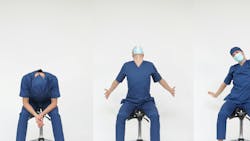5 things to know about your body before practicing dental hygiene
For many of us, dental hygiene is a profession that affords us the freedom to spend time with our families and friends on evenings and weekends, the fulfillment of relationship building with patients while providing whole-body comprehensive care. We are the confidantes, the cheerleaders, and the trusted educators who keep patients coming back for more. But at what cost?
Related reading:
- Use caution when ordering ergonomic products online
- The ergonomics of our grips on dental instruments
- Promoting health and wellness of dental professionals throughout their career
It’s no secret to those of us who have been in dental for a while that body pain is commonplace (up to 96% of hygienists report body pain) and that there is a major workforce shortage for hygienists, especially post-pandemic. When prompted for pros and cons for becoming a hygienist on nearly any social media dental hygiene platform, one can expect numerous comments saying “your body won’t last.”
On the other hand, a Google search would have prospective hygienists believe that we basically polish and scrape teeth off and on during the day while sitting on piles of gold, being fed grapes by a statuesque dental assistant. Quite a contradiction, yet we don’t get the real scoop until we’re elbow up in a 6 mm pocket at 4:55 pm on a Thursday after our first full month of practice in the real world. If only someone had told us what to expect when considering this career, we could’ve prepared!
If you’re a student, a new hygienist, or even a seasoned pro who wants to find ways to extend the pain-free portion of your career, this one's for you. Here are five things to know about dental hygiene and your body.
Your back is your best friend
No matter how you practice (sitting or standing), the nature of leaning, or worse—hunching over to see into the mouth—is the equivalent to water on a beach pulling sand out from under a castle.1 The back is the postural workhorse of the body, and it needs TLC to go the distance. To avoid becoming the hunchback hygienist, invest in a quality saddle stool with height and seat pan tilt adjustments to keep the spine in neutral, hips even, and feet flat on the floor at an angle that conforms to the user’s body. A chair should be fit to the user like loupes are, therefore when you get one that fits you, you want to take it with you if you leave that practice. Consider proposing an ergonomic equipment fund to be earned instead of a cash bonus with the practice owner. They get the production and the tax write-off, you get to keep the equipment.
Muscle development is a major player in maintaining good posture
Bones don’t hold the body up without muscle, hence musculoskeletal system. Just as bone density tends to decrease over time, we also lose about 1lb of the 70lbs (ish) of muscle in our body every decade past the age of 30. If we want to maintain posture that keeps us out of pain, it’s imperative to continue muscle growth. Bonus points are given for strength training as we grow muscle and build bone density at the same time. Compound movements like squats, mobility work like burpees, and isometric holds like planks are all great ways to build core and full body muscles.2 Consider working with a personal trainer who has dental hygiene experience to put together a posture enhancement workout program.
Seeing is believing
Focusing intently into a three-inch space at the level of your belly button for hours a day without magnification and illumination is a hot mess of pain waiting to happen. To no one’s surprise, the neck is the number one reported body part in pain for hygienists. On top of that, tiny eye muscles are overused causing strain and premature loss of eyesight. For this reason, loupes are required at almost all dental hygiene schools. Protect the neck and the eyes with prismatic “ergo” loupes that keep the eyes looking forward and don’t contract the depressor muscles of the eyes to keep them looking down. This design also keeps the neck in neutral, alleviating the recruitment of the levator scapulae, upper trapezius, and deep cervical muscles in the neck to hold the neck down.3 Also, consider the American Osteopathic Association (AOA) suggestion of looking 20 feet away for 20 seconds every 20 minutes and occasionally close the lids while rolling the eyes around to lubricate and the muscles to rest.
Your hands are your moneymakers
The many tiny muscles in the hands are responsible for the hundreds of fine motor skill movements required to blindly scale, curettage, and explore for removal of soft and hard deposits on the teeth. Learn to use mechanized scaling with a soft grip as the primary modality over a death grip on pencil-thin instruments, as pinch force in the fingers is the beginning of the chain of pain that we ultimately feel in our neck, back, and shoulders.4,5 Keep prevention in mind by stretching the fingers, palms, thumbs, and wrists often and strengthen the lesser-used hand muscles by gripping Silly Putty or squeezing foam. Ergonomic coaching during practice is another way to help with instrumentation, operator, and patient positioning. If those things are off, we often grip harder on the instrument in our hands to accommodate that imbalance.
Take a mental timeout
A hygiene room can be a receptacle for dumping all kinds of patient traumas, fears, life events—good and bad. The emotional climate in the room can be extremely low one hour to extremely high the next, and we’re along for the ride, giving pieces of ourselves to every patient who sits in the chair in the form of advice, demonstrated excitement, condolences, and pep talks. All. Day. Long. At some point, preferably every day, we need to refill our own cup. Taking a few minutes to leave the office for a mental exhale isn’t just nice. It’s vital to your ability to show up as the trusted provider that the remaining patients deserve to get for the rest of the day. We owe it to them, and we owe it to ourselves. Take a lunch and a walk. Get some air and some sunshine. Practice breathing techniques or do some gentle yoga.6
There will always be ‘those days’ when we leave the office feeling like we’ve been dragged through the mud, but by turning a preventive mindset toward ourselves, we can avoid the physical and mental burnout that so many experience. After all, we are prevention specialists, right?
Editor's note: This article appeared in the January/February 2024 print edition of RDH magazine. Dental hygienists in North America are eligible for a complimentary print subscription. Sign up here.
References
- Pejčić N, Đurić-Jovičić M, Miljković N, Popović DB, Petrović V. Posture in dentists: Sitting vs. standing positions during dentistry work: an EMG study. Srpski Arhiv Za Celokupno Lekarstvo. 2016;144:181–187.
- Holzgreve F, Fraeulin L, Maurer-Grubinger C, et al. Effects of resistance training as a behavioural preventive measure on musculoskeletal complaints, maximum strength and ergonomic risk in dentists and dental assistants. Sensors (Basel). 2022;22(20):8069. doi:10.3390/s22208069
- Lietz J, Ulusoy N, Nienhaus A. Prevention of musculoskeletal diseases and pain among dental professionals through ergonomic interventions: a systematic literature review. Int J Environ Res Public Health. 2020;17(10):3482. doi:10.3390/ijerph17103482
- La Delfa NJ, Grondin DE, Cox J, Potvin JR, Howarth SJ. The biomechanical demands of manual scaling on the shoulders and neck of dental hygienists. Ergon. 2017;60(1):127-137.
- Edwards C, Fortingo N, Franklin E. Ergonomics. In: StatPearls [Internet].StatPearls Publishing; 2023. Available from:
https://www.ncbi.nlm.nih.gov/books/NBK580551 - Díaz-Silveira C, Alcover CM, Burgos F, Marcos A, Santed MA. Mindfulness versus physical exercise: effects of two recovery strategies on mental health, stress and immunoglobulin A during lunch breaks. A randomized controlled trial. Int J Environ Res Public Health. 2020;17(8):2839. doi:10.3390/ijerph17082839
Katrina Klein, RDH, CEAS, CPT, is a 15-year registered dental hygienist, national speaker, author, competitive bodybuilder, certified personal trainer, certified ergonomic assessment specialist, and biomechanics nerd. She’s the founder of ErgoFitLife, where she teaches that ergonomics and fitness are a lifestyle to prevent, reduce, and even eliminate workplace pain.
About the Author

Katrina Klein, RDH, CEAS, CPT
Katrina is an 18-year registered dental hygienist, national speaker, author, competitive bodybuilder, certified personal trainer, certified ergonomic assessment specialist, and biomechanics nerd. She’s the founder of ErgoFitLife, where she teaches that ergonomics and fitness are a lifestyle to prevent, reduce, and even eliminate workplace pain. You can reach Katrina at [email protected].
